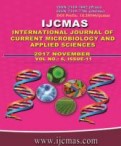


 National Academy of Agricultural Sciences (NAAS)
National Academy of Agricultural Sciences (NAAS)

|
PRINT ISSN : 2319-7692
Online ISSN : 2319-7706 Issues : 12 per year Publisher : Excellent Publishers Email : editorijcmas@gmail.com / submit@ijcmas.com Editor-in-chief: Dr.M.Prakash Index Copernicus ICV 2018: 95.39 NAAS RATING 2020: 5.38 |
The major thrust in dairy cattle breeding programme has been to identify potential parents with high breeding value for next generation. In general, two breeding strategies are available for improvement of cattle, i.e. selective breeding with in a breed and cross breeding among breeds (Falconer and Mackay, 1996). For the formulation of effective genetic improvement programme, basic knowledge of genetic parameters of a herd must be known with maximum accuracy. To improve the efficiency and accuracy of sire evaluation programmes many sire indices has been developed by using the procedures of Simple Daughter Average (SDA), Ordinary Least-squares (OLS), Regressed Least-Squares (RLS), Best Linear Unbiased Prediction (BLUP) and Derivative free restricted maximum likelihood (DFREML).The comparison of efficiency of these sire evaluation methods was done by using the different criteria like coefficient of determination, coefficient of variation, rank correlations and error variance. The literature is dotted with conflicting reports (Pundir et al., 2004; Dhaka et al., 2004; Banik and Gandhi, 2006; Raja, 2010) on comparative evaluation of various sire evaluation techniques. The BLUP method was found to be more efficient, accurate in the some studies. While in some studies the derivative free restricted maximum likelihood method was superior over other methods. This review summarizes findings of various researches relating to comparative efficiency of sire evaluation methods for estimation of breeding values for efficient selection in animal breeding.
 |
 |
 |
 |
 |